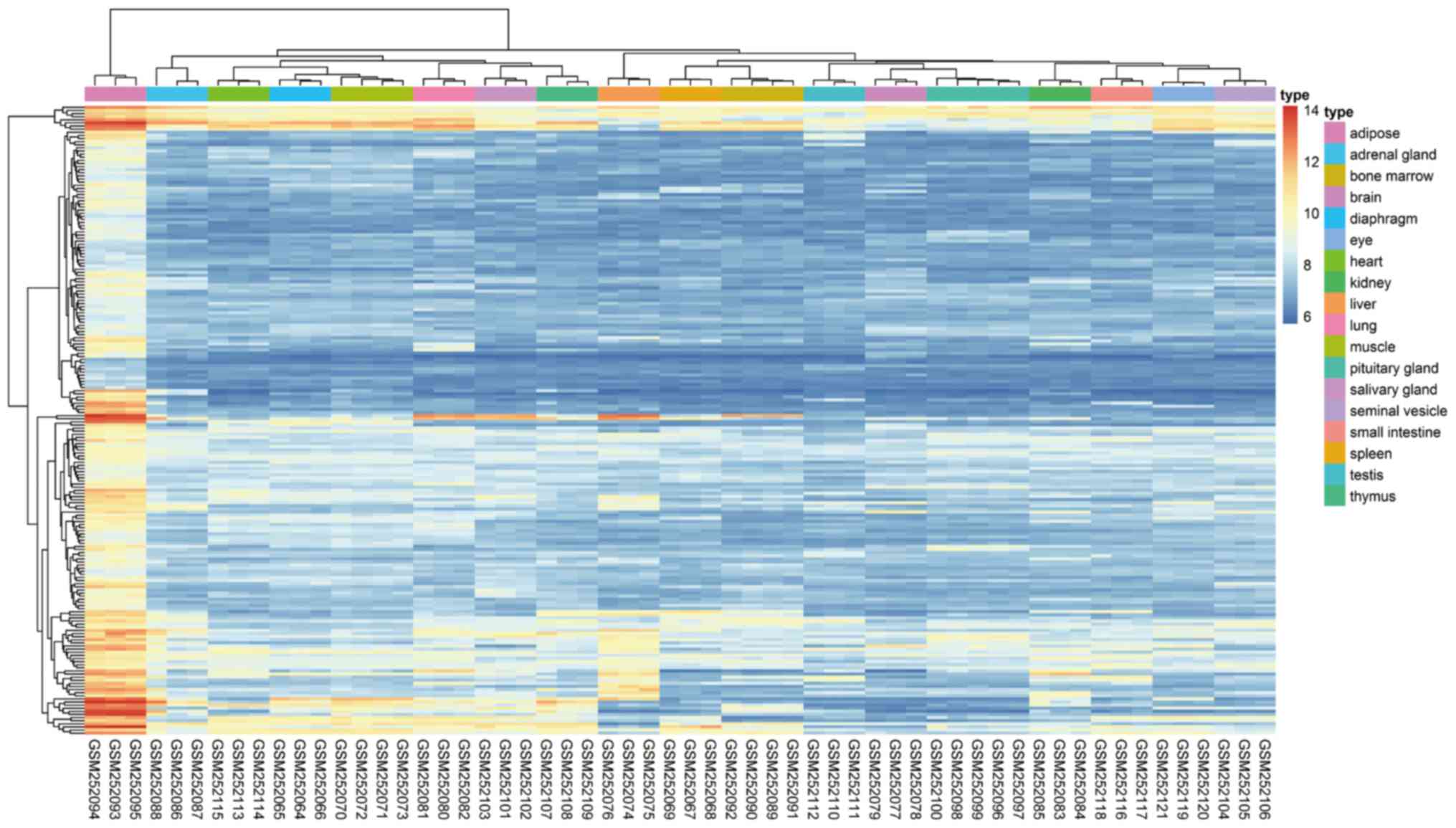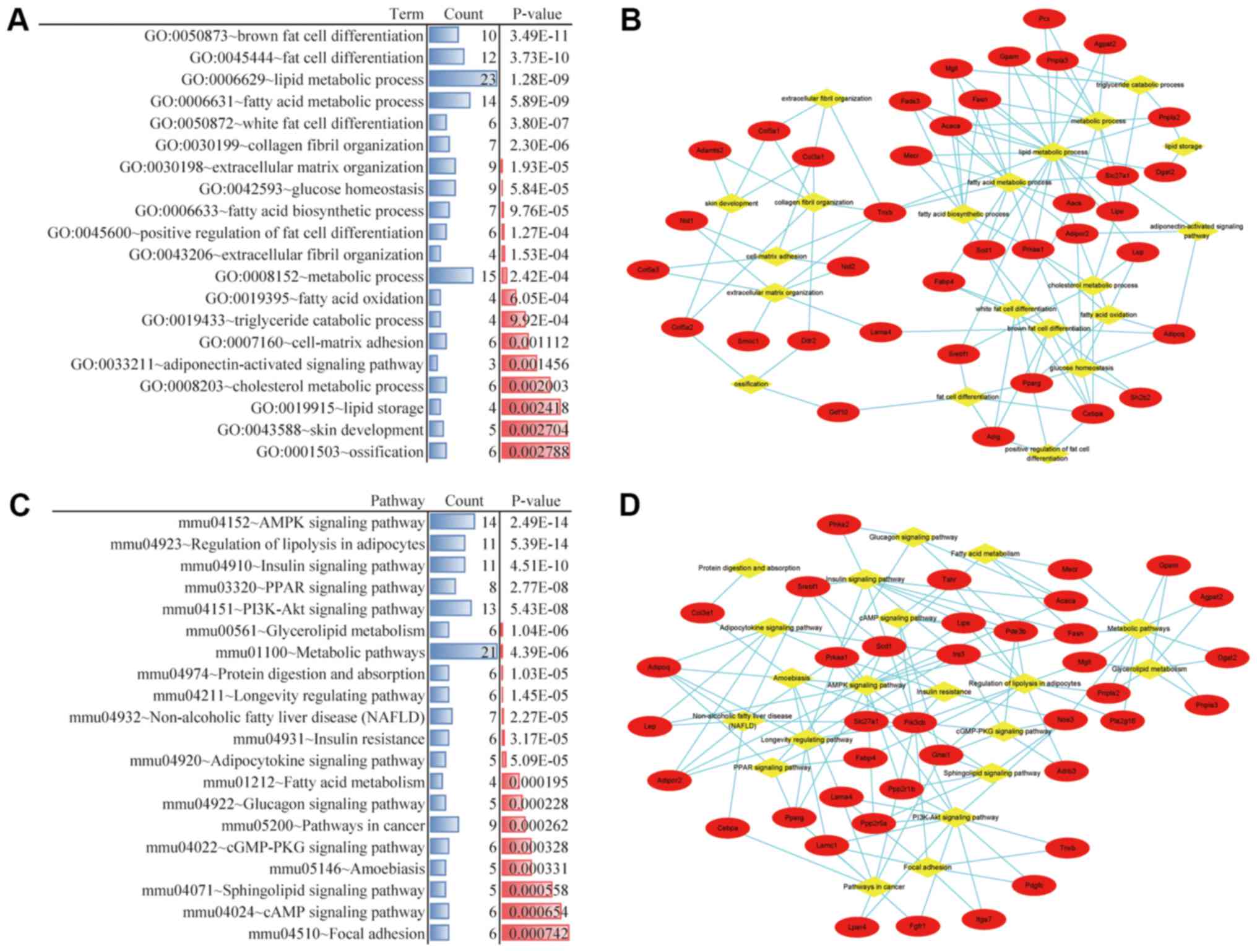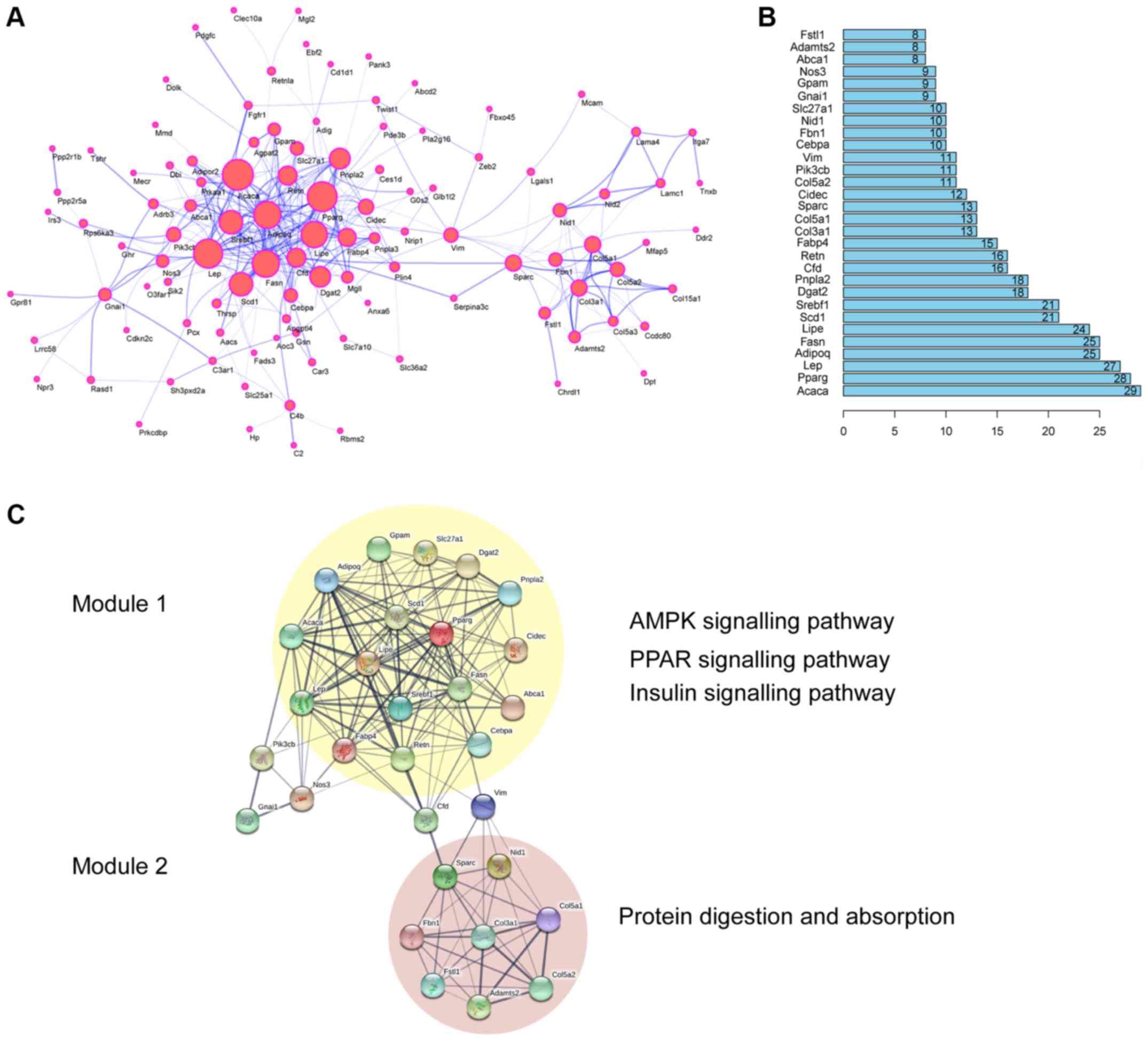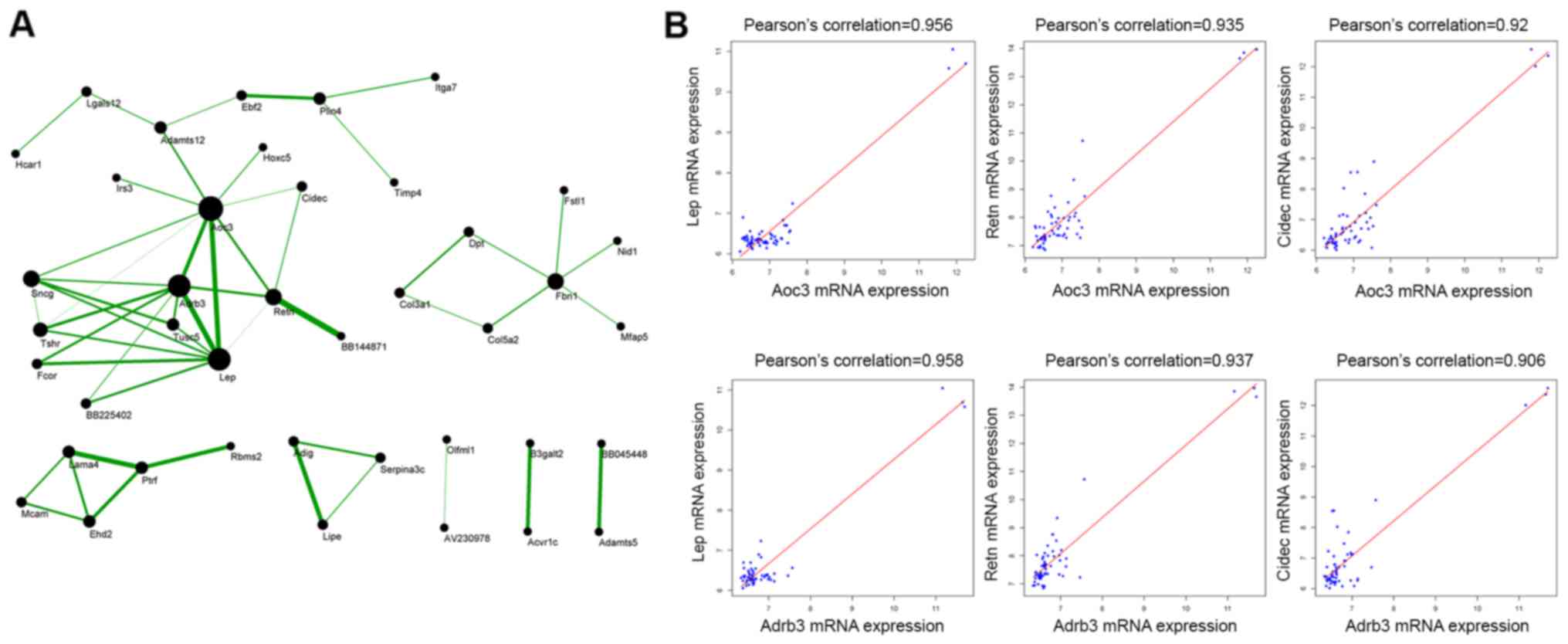|
1
|
World Health Organization. Obesity and
overweight. http://www.who.int/news-room/fact-sheets/detail/obesity-and-overweightMarch
8–2018
|
|
2
|
Hajer GR, van Haeften TW and Visseren FL:
Adipose tissue dysfunction in obesity, diabetes, and vascular
diseases. Eur Heart J. 29:2959–2971. 2008. View Article : Google Scholar : PubMed/NCBI
|
|
3
|
Oda E: Historical perspectives of the
metabolic syndrome. Clin Dermatol. 36:3–8. 2018. View Article : Google Scholar : PubMed/NCBI
|
|
4
|
Moreno-Navarrete JM and Fernández-Real JM:
Adipocyte differentiation. Adipose tissue biology. ‘Vol’. Springer;
pp. 69–90. 2017, View Article : Google Scholar
|
|
5
|
Ali AT, Hochfeld WE, Myburgh R and Pepper
MS: Adipocyte and adipogenesis. Eur J Cell Biol. 92:229–236. 2013.
View Article : Google Scholar : PubMed/NCBI
|
|
6
|
Spalding KL, Arner E, Westermark PO,
Bernard S, Buchholz BA, Bergmann O, Blomqvist L, Hoffstedt J,
Näslund E, et al: Dynamics of fat cell turnover in humans. Nature.
453:783–787. 2008. View Article : Google Scholar : PubMed/NCBI
|
|
7
|
Gustafson B, Hedjazifar S, Gogg S,
Hammarstedt A and Smith U: Insulin resistance and impaired
adipogenesis. Trends Endocrin Metab. 26:193–200. 2015. View Article : Google Scholar
|
|
8
|
Hirsch J and Batchelor B: Adipose tissue
cellularity in human obesity. Clin Endocrinol Metab. 5:299–311.
1976. View Article : Google Scholar : PubMed/NCBI
|
|
9
|
Ahima RS and Flier JS: Adipose tissue as
an endocrine organ. Trends Endocrinol Metab. 11:327–332. 2000.
View Article : Google Scholar : PubMed/NCBI
|
|
10
|
Ducharme NA and Bickel PE: Lipid droplets
in lipogenesis and lipolysis. Endocrinology. 149:942–949. 2008.
View Article : Google Scholar : PubMed/NCBI
|
|
11
|
Gregoire FM, Smas CM and Sul HS:
Understanding adipocyte differentiation. Physiol Rev. 78:783–809.
1998. View Article : Google Scholar : PubMed/NCBI
|
|
12
|
Barrett T, Suzek TO, Troup DB, Wilhite SE,
Ngau WC, Ledoux P, Rudnev D, Lash AE, Fujibuchi W and Edgar R: NCBI
GEO: Mining millions of expression profiles-database and tools.
Nucleic Acids Res. 33:(Database Issue). D562–D566. 2005. View Article : Google Scholar : PubMed/NCBI
|
|
13
|
Kaplan S, Boztepe S and Arikoglu H: The
potential of microarray databases to identify tissue specific
genes. Kafkas Univ Vet Fak. 22:29–35. 2016.
|
|
14
|
Ullah M, Stich S, Häupl T, Eucker J,
Sittinger M and Ringe J: Reverse differentiation as a gene
filtering tool in genome expression profiling of adipogenesis for
fat marker gene selection and their analysis. PLoS One.
8:e697542013. View Article : Google Scholar : PubMed/NCBI
|
|
15
|
Fujioka S, Matsuzawa Y, Tokunaga K,
Kawamoto T, Kobatake T, Keno Y, Kotani K, Yoshida S and Tarui S:
Improvement of glucose and lipid metabolism associated with
selective reduction of intra-abdominal visceral fat in
premenopausal women with visceral fat obesity. Int J Obes.
15:853–859. 1991.PubMed/NCBI
|
|
16
|
Thorrez L, Van Deun K, Tranchevent LC, Van
Lommel L, Engelen K, Marchal K, Moreau Y, Van Mechelen I and Schuit
F: Using ribosomal protein genes as reference: A tale of caution.
PLoS One. 3:e18542008. View Article : Google Scholar : PubMed/NCBI
|
|
17
|
Hastie T, Tibshirani R, Narasimhan B and
Chu G: Impute: Imputation for microarray data. Bioinformatics.
17:520–525. 2001.PubMed/NCBI
|
|
18
|
Ritchie ME, Phipson B, Wu D, Hu Y, Law CW,
Shi W and Smyth GK: limma powers differential expression analyses
for RNA-sequencing and microarray studies. Nucleic Acids Res.
43:e472015. View Article : Google Scholar : PubMed/NCBI
|
|
19
|
Tripathi S, Pohl MO, Zhou Y,
Rodriguez-Frandsen A, Wang G, Stein DA, Moulton HM, DeJesus P, Che
J, Mulder LC, et al: Meta- and orthogonal integration of influenza
‘OMICs’ data defines a role for UBR4 in virus budding. Cell Host
Microbe. 18:723–735. 2015. View Article : Google Scholar : PubMed/NCBI
|
|
20
|
Wu J, Mao X, Cai T, Luo J and Wei L: KOBAS
server: A web-based platform for automated annotation and pathway
identification. Nucleic Acids Res. 34:W720–W724. 2006. View Article : Google Scholar : PubMed/NCBI
|
|
21
|
Xie C, Mao X, Huang J, Ding Y, Wu J, Dong
S, Kong L, Gao G, Li CY and Wei L: KOBAS 2.0: A web server for
annotation and identification of enriched pathways and diseases.
Nucleic Acids Res. 39:W316–W322. 2011. View Article : Google Scholar : PubMed/NCBI
|
|
22
|
Franceschini A, Szklarczyk D, Frankild S,
Kuhn M, Simonovic M, Roth A, Lin J, Minguez P, Bork P, von Mering C
and Jensen LJ: STRING v9.1: Protein-protein interaction networks,
with increased coverage and integration. Nucleic Acids Res.
41:(Database Issue). D808–D815. 2013. View Article : Google Scholar : PubMed/NCBI
|
|
23
|
Shannon P, Markiel A, Ozier O, Baliga NS,
Wang JT, Ramage D, Amin N, Schwikowski B and Ideker T: Cytoscape: A
software environment for integrated models of biomolecular
interaction networks. Genome Res. 13:2498–2504. 2003. View Article : Google Scholar : PubMed/NCBI
|
|
24
|
Bader GD and Hogue CW: An automated method
for finding molecular complexes in large protein interaction
networks. BMC Bioinformatics. 4:22003. View Article : Google Scholar : PubMed/NCBI
|
|
25
|
Langfelder P and Horvath S: WGCNA: An R
package for weighted correlation network analysis. BMC
Bioinformatics. 9:5592008. View Article : Google Scholar : PubMed/NCBI
|
|
26
|
Vázquez-Vela ME, Torres N and Tovar AR:
White adipose tissue as endocrine organ and its role in obesity.
Arch Med Res. 39:715–728. 2008. View Article : Google Scholar : PubMed/NCBI
|
|
27
|
Rosen ED, Walkey CJ, Puigserver P and
Spiegelman BM: Transcriptional regulation of adipogenesis. Genes
Dev. 14:1293–1307. 2000.PubMed/NCBI
|
|
28
|
Fernández-Galilea M, Pérez-Matute P,
Prieto-Hontoria PL, Sáinz N, López-Yoldi M, Houssier M, Martínez
JA, Langin D and Moreno-Aliaga MJ: α-lipoic acid reduces fatty acid
esterification and lipogenesis in adipocytes from overweight/obese
subjects. Obesity (Silver Spring). 22:2210–2215. 2014. View Article : Google Scholar : PubMed/NCBI
|
|
29
|
Minokoshi Y, Kim YB, Peroni OD, Fryer LG,
Müller C, Carling D and Kahn BB: Leptin stimulates fatty-acid
oxidation by activating AMP-activated protein kinase. Nature.
415:339–343. 2002. View
Article : Google Scholar : PubMed/NCBI
|
|
30
|
Rosen ED and MacDougald OA: Adipocyte
differentiation from the inside out. Nat Rev Mol Cell Biol.
7:885–896. 2006. View
Article : Google Scholar : PubMed/NCBI
|
|
31
|
Song NJ, Kim S, Jang BH, Chang SH, Yun UJ,
Park KM, Waki H, Li DY, Tontonoz P and Park KW: Small
molecule-induced complement factor D (Adipsin) promotes lipid
accumulation and adipocyte differentiation. PLoS One.
11:e1622282016.
|
|
32
|
Meier U and Gressner AM: Endocrine
regulation of energy metabolism: Review of pathobiochemical and
clinical chemical aspects of leptin, ghrelin, adiponectin, and
resistin. Clin Chem. 50:1511–1525. 2004. View Article : Google Scholar : PubMed/NCBI
|
|
33
|
Damen MSMA, Dos Santos JC, Hermsen R, Adam
van der Vliet J, Netea MG, Riksen NP, Dinarello CA, Joosten LAB and
Heinhuis B: Interleukin-32 upregulates the expression of ABCA1 and
ABCG1 resulting in reduced intracellular lipid concentrations in
primary human hepatocytes. Atherosclerosis. 271:193–202. 2018.
View Article : Google Scholar : PubMed/NCBI
|
|
34
|
Tanos R, Murray IA, Smith PB, Patterson A
and Perdew GH: Role of the Ah receptor in homeostatic control of
fatty acid synthesis in the liver. Toxicol Sci. 129:372–379. 2012.
View Article : Google Scholar : PubMed/NCBI
|
|
35
|
Stahl A: A current review of fatty acid
transport proteins (SLC27). Pflugers Arch. 447:722–727. 2004.
View Article : Google Scholar : PubMed/NCBI
|
|
36
|
Hertzel AV and Bernlohr DA: The mammalian
fatty acid-binding protein multigene family: Molecular and genetic
insights into function. Trends Endocrinol Metab. 11:175–180. 2000.
View Article : Google Scholar : PubMed/NCBI
|
|
37
|
Smith SJ, Cases S, Jensen DR, Chen HC,
Sande E, Tow B, Sanan DA, Raber J, Eckel RH and Farese RV Jr:
Obesity resistance and multiple mechanisms of triglyceride
synthesis in mice lacking Dgat. Nat Genet. 25:87–90. 2000.
View Article : Google Scholar : PubMed/NCBI
|
|
38
|
Takeuchi K and Reue K: Biochemistry,
physiology, and genetics of GPAT, AGPAT, and lipin enzymes in
triglyceride synthesis. Am J Physiol Endocrinol Metab.
296:E1195–E1209. 2009. View Article : Google Scholar : PubMed/NCBI
|
|
39
|
Li Y, Kang H, Chu Y, Jin Y, Zhang L, Yang
R, Zhang Z, Zhao S and Zhou L: Cidec differentially regulates lipid
deposition and secretion through two tissue-specific isoforms.
Gene. 641:265–271. 2018. View Article : Google Scholar : PubMed/NCBI
|
|
40
|
Reilich P, Horvath R, Krause S, Schramm N,
Turnbull DM, Trenell M, Hollingsworth KG, Gorman GS, Hans VH,
Reimann J, et al: The phenotypic spectrum of neutral lipid storage
myopathy due to mutations in the PNPLA2 gene. J Neurol.
258:1987–1997. 2011. View Article : Google Scholar : PubMed/NCBI
|
|
41
|
Hernandez-Guillamon M, Solé M, Delgado P,
García- Bonilla L, Giralt D, Boada C, Penalba A, García S, Flores
A, Ribó M, et al: VAP-1/SSAO plasma activity and brain expression
in human hemorrhagic stroke. Cerebrovasc Dis. 33:55–63. 2012.
View Article : Google Scholar : PubMed/NCBI
|
|
42
|
Schilter HC, Collison A, Russo RC, Foot
JS, Yow TT, Vieira AT, Tavares LD, Mattes J, Teixeira MM and
Jarolimek W: Effects of an anti-inflammatory VAP-1/SSAO inhibitor,
PXS-4728A, on pulmonary neutrophil migration. Resp Res. 16:422015.
View Article : Google Scholar
|
|
43
|
Bour S, Daviaud D, Gres S, Lefort C,
Prévot D, Zorzano A, Wabitsch M, Saulnier-Blache J, Valet P and
Carpéné C: Adipogenesis-related increase of semicarbazide-sensitive
amine oxidase and monoamine oxidase in human adipocytes. Biochimie.
89:916–925. 2007. View Article : Google Scholar : PubMed/NCBI
|
|
44
|
Manolio TA, Collins FS, Cox NJ, Goldstein
DB, Hindorff LA, Hunter DJ, McCarthy MI, Ramos EM, Cardon LR,
Chakravarti A, et al: Finding the missing heritability of complex
diseases. Nature. 461:747–753. 2009. View Article : Google Scholar : PubMed/NCBI
|
|
45
|
Nakashima H, Omae K, Nomiyama T, Yamano Y,
Takebayashi T and Sakurai Y: Beta-3-adrenergic receptor Trp64Arg
polymorphism: Does it modulate the relationship between exercise
and percentage of body fat in young adult Japanese males? Environ
Health Prev Med. 18:323–329. 2013. View Article : Google Scholar : PubMed/NCBI
|


















